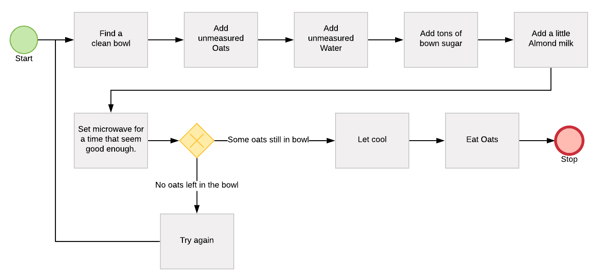In this article, we will cover it all - process mapping definitions, benefits, importance, limitations, tools, and examples.
Introduction
When you plan the itinerary for your vacation, you tend to jot down all the things that are on your wishlist. From restaurants and local pubs to beaches and hiking points, you do not want to miss adding anything to your week-long itinerary.
I usually go down the old fashioned way and use pen and paper to sketch out my plan. Some use whiteboards while having a debate with their spouse on whether to skip that coffee shop trip. And then there are the fancy ones with pin boards and landscape pictures all hanging by a thread looking pretty.
The point here is to see if whether or not this visual representation of your itinerary is helpful. Let's see how it can be helpful:
-
Covers your entire wishlist
-
Helps you figure if you missed out on anything
-
Helps you prioritize the activities considering time, weather, and other factors
-
Helps you bring the entire plan together
-
Helps you make changes in case something does not look right (like that coffee shop you planned to visit needs a long detour)
-
And a lot more
Business process mapping is a similar concept that helps you visualize a business process to understand it better. It outlines the workflow of your business processes to improve the efficiency and effectiveness of business operations.
Business process mapping is a significant part of business process documentation, but it has its limitations too. To understand the concept better, we will find the answers to questions such as - How is process mapping different from process management? What are the benefits of process mapping? Should you consider mapping your processes? What are the limitations of process mapping?
Table of Content
What is Business Process Mapping?
Business process mapping is defined as the activity of creating a workflow diagram of a process to gain a clear understanding of the process and how it overlaps with other processes. It is a business process documentation tool that uses visual aids to document and communicate the details of a process across the company.
A process map outlines every activity, role, and business entity involved in the business process. The goal of a process map is to document, understand, and improve business processes.
With the use of symbols and flowcharts, a process map simplifies the understanding, interpretation, and workflow of a process. It gives clarity on who is responsible for a task in a process, what is the standardized method of executing a process, and what is the goal of the process.
Let us take a simple day-to-day example of using a process map. Everyone has a go-to breakfast meal that they gobble up before their morning meetings - mine is oats.
Every morning I wake up and go straight to the kitchen to make a bowl of oats and black coffee. I like to wing it when it comes to my morning oats. I ignore the tested and proven process of making the perfect bowl of oats provided by the brand. I recklessly add unmeasured oats and water to a bowl, and set the microwave for a time I feel is sufficient.
Result? Spilled over oats in the microwave.

Let's map my current process of oats-making it into a process map

Clearly, there is room for improvement which I can pinpoint using this process map. With some modifications to the process using the process map, I have figured out the perfect way to make my morning oats.
The improved process looks something like this:

There you have it - a perfect bowl of oats!
We achieved the desired process outcome by visually documenting the process and making tweaks where there was room for improvement.

Just like making oats, mapping important business processes helps you uncover your current operations and identify revenue leaks and operational gaps in your processes.
Business Process Mapping vs. Business Process Management
Business process mapping is a process documentation technique used to visually represent a process workflow to understand, interpret, and improve the existing process.
Business process management is defined as a discipline in operations management in which people use various methods to discover, model, analyze, measure, improve, optimize, and automate business processes.
Process mapping is a method used in the practice of business process management. The goal of process mapping is to document, analyze, and improve business processes. Process mapping, along with many other methods, entails the practice of business process management. Learn more about Business Process Management (BPM).

Types of Process Maps
There are several types of process maps, each serving a specific purpose. Here are some common types:
Flowchart: These use shapes and arrows to show the steps in a process and how things move from one step to another. They work for simple and complex processes.
Swimlane Map: This adds lanes to the flowchart, like different lanes in a swimming pool. Each lane represents a different group or person involved in the process.
Value Stream Map: Think of this as a map that shows how things go from raw materials to the final product or service. It helps find ways to make things better.
SIPOC Diagram: Imagine a recipe list: Suppliers give ingredients, you follow a Process, and you end up with Outputs that Customers enjoy. This map keeps things clear.
Data Flow Diagram: This shows how information moves through a system, like a road map for data. It's useful for tech stuff.
Gantt Chart: Like a timeline puzzle, this helps plan when different tasks happen in a project.
Storyboard: Think of it as a comic strip for planning stories or designs. It's good for creative work.
Mind Map: It's like a big web of ideas. Use it when you're brainstorming or organizing thoughts.
Process Matrix: This helps see how different parts of a process work together, like connecting puzzle pieces.
Deployment Flowchart: Imagine a game plan for who does what in a team. This map helps show who's responsible for each task.
Remember, choose the map that fits your process and what you want to understand. Simple maps are good for simple things, and more complex maps work for bigger challenges.
Why Is Business Process Mapping Important?
Business processes are multi-layered, tangled, and complex structures. which makes process mapping a useful but difficult activity. Before you start investing time and effort into mapping your processes, let us understand why mapping them is important in the first place.
It helps you understand your existing process
As I said before, your business processes are multi-layered, tangled, and complex structures that include steps, methods, employees, teams, departments, pre-requisites, and a lot more. And before you even start thinking of improving your business processes, you need to understand them inside out in their existing state.
Process mapping helps you do just that! Mapping your processes will help you understand your processes in their 'as is' state. You get a birds-eye view of your business process - steps, activities, teams involved, process overlaps, silos, and process gaps.
It gets the processes out of you and your team's head
Process maps are a great way to build a reference document by getting the process details out of you and your teams' heads and down on paper. This way, there are fewer information silos within your business operations.
When your processes are mapped and not inside your teams' head, there is:
-
Less to-and-fro communication for minor process details
-
More sense of accountability within the team
-
Easy breakdown of process tasks and workflows
-
Instructions that can be referenced if an employee leaves or gets sick
It helps you visualize your processes
A process map lays out all the elements of your process - tasks, procedures, employees, teams, departments, workflows, etc. It is not easy to keep account of all these elements while you take care of other business operations.
Visualizing your processes helps you decipher the complexity of your business processes. Business process mapping helps you visually represent your process, allowing you to see how your process pans out.
It allows you to identify problem areas
Mapping your processes gives you a visual representation of your process. It helps you identify overlaps and correlations, as well as gaps and revenue leaks. Gaps in your process can be sources of revenue leaks and operational gaps where tasks fall through the cracks. Process maps are the first step towards eliminating them. Once you lay it out, you can clean it out!
3 Easy-to-use Process Mapping Software Tools
Process mapping software tools are the most effective and efficient solution for mapping elaborate business processes. They simplify the tasks of creating, editing, and sharing the process maps across the organization.
Here are a few process mapping tools that can get you started:
Unlike its competitors, LucidChart is a customized tool built for creating process maps. Its features and functionalities are tailor-made for process mapping. The tool offers:
-
A ton of templates to get you started without blowing your mind off
-
An easy-to-use interface that makes it more appealing than other tools
-
Easy on the pockets for beginners
-
Storage capacity for graphs and other media
Another dedicated software tool to create process maps, Microsoft Visio is an excellent solution to visualizing your processes. It is a powerful tool with robust features for large, complex business operations, making it more expensive than other tools. Some things to consider would be:
-
Robust process mapping solutions
-
Ideal for large complex business operations
-
Wide range of templates
-
OneDrive storage to share diagrams
Miro is another easy-to-use process mapping tool that simplifies process mapping for businesses of all sizes. It is an intuitive process mapping tool with a central cloud-based mapping repository that eliminates silos. The tool offers:
-
Existing mapping templates
-
Simplified collaboration for brainstorming sessions
-
Useful for all business processes
Mapping Your Own Processes
Process mapping is an elaborate exercise that requires time, effort, and dedication to analyze and improve existing business processes. There are two ways of mapping your process - internally and externally.
Mapping your own processes without external help is practiced by many organizations using research material and mapping tools. Let us take a look at some pros and cons of mapping your own processes:
Pros:
-
You know your processes best, so listing the process steps and procedures is easier
-
You know who is responsible for each activity and you can reach out to them for details
-
There is no dependency on an external partner
-
Little to no cost
Cons:
-
Lack of expertise in process mapping
-
Need for extra bandwidth to execute process mapping
-
Frustration caused by defining multiple process swimlanes
-
Impact on day-to-day business operations and priorities
-
Lack of process knowledge
Processology has partnered with many businesses to help them streamline their processes using business process management techniques like process mapping.
Why Should You Consider Mapping Your Processes?
There are many reasons to consider mapping your processes, but let us look at the most common reasons why businesses invest in process mapping:
Inefficient and ineffective processes
This one is a no-brainer - you know when it is time to put your foot down. Inefficient processes cause operational breakdowns, affecting process outcomes. This in-turn affects employee morale and customer satisfaction, which is unacceptable.
The next step you need to take is to map your processes to identify gaps and start improvements.
Revenue leaks and operational gaps
Even though your processes are working out and do not need fixing, there is always room for improvement. If you intend to save costs and effort with preventive measures, process mapping is the right thing to do.
Process maps give you a visual summary of your business processes, allowing you to point out the revenue leaks and operational gaps so that you can act on them immediately.
You don't know what you don't know. Process mapping will uncover hidden problems hindering growth and innovation.
Employee Burnout and frustration
A business nightmare looks like a vicious cycle: inefficient process - operational gaps - impact on customer satisfaction - employee burnouts - more inefficient processes...
Employee burnout is a common symptom o inefficient operations. From lack of accountability and transparency to duplication of efforts and lack of standardization, the impact of inefficient processes is huge. And the first step to remedy this is to map your existing processes.
Limitations of Business Process Mapping
Although process mapping has its fair share of benefits, it also has certain limitations. Let's take a look at some common instances where process mapping is not enough:
Process Handoffs
Business process handoff is the transfer of knowledge, documentation, and other elements of a process from one employee, team, or department to the other. For example, the onboarding of a new employee requires process handoff that includes training material, documentation, knowledge transfer, and processes related files.
In this case, a process map is not enough, as it only provides an overview of the process elements and their connections. It lacks the details of the process required for a process handoff. Learn more about process handoffs.
Detailed Assessment or Analysis
There are instances when you need a detailed rundown of a process - from steps involved and procedures followed. A summary and overview of the process are not sufficient. Hence, process maps are not enough when it comes down to a detailed analysis of processes.
Conclusion
Business process mapping is an important component of business process management. It helps you understand the “who,” “what,” “when,” “where” and “how” of a process, and help to analyze the “why'' of it. Map your business process with the experienced team at Processology.



